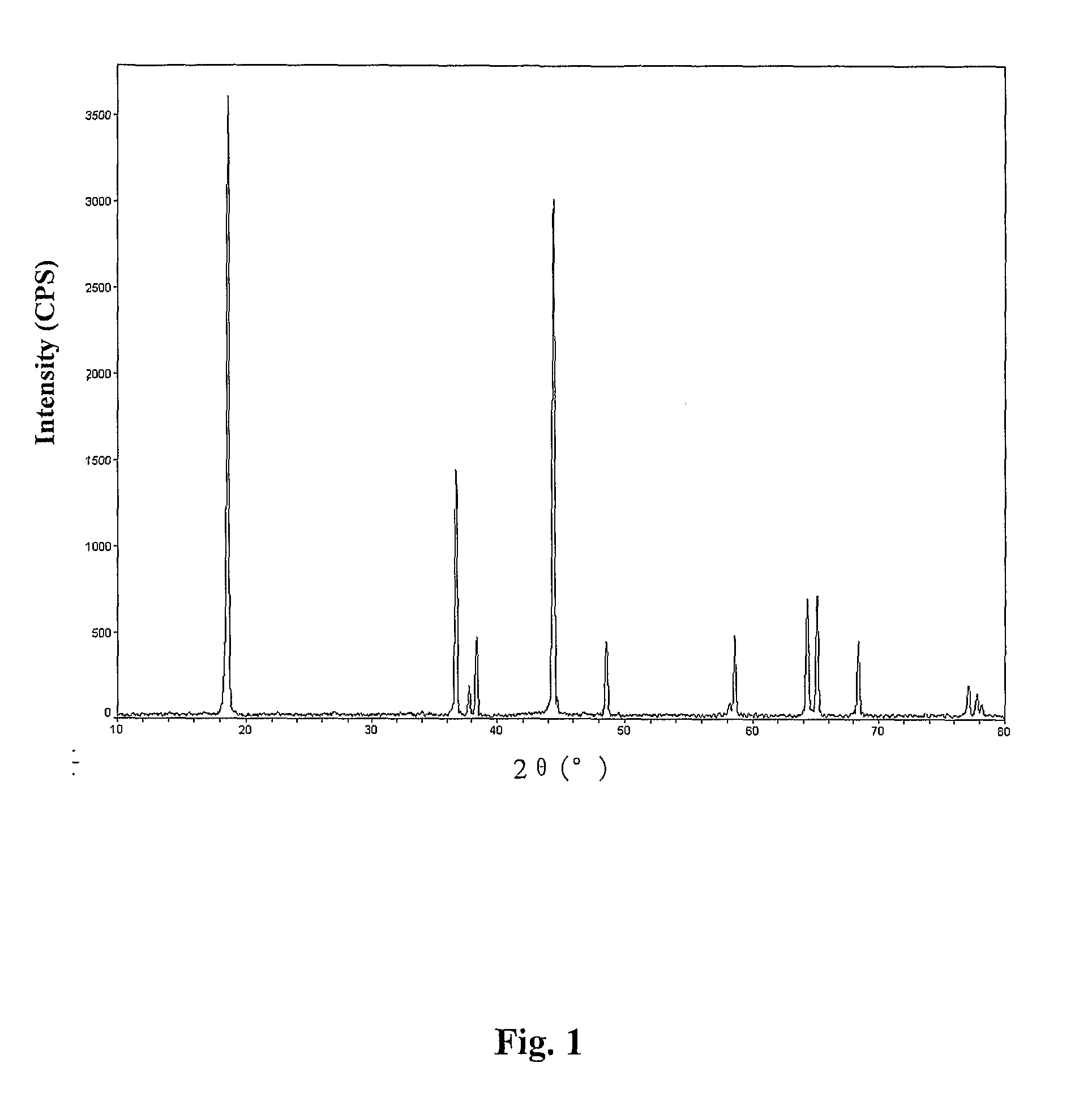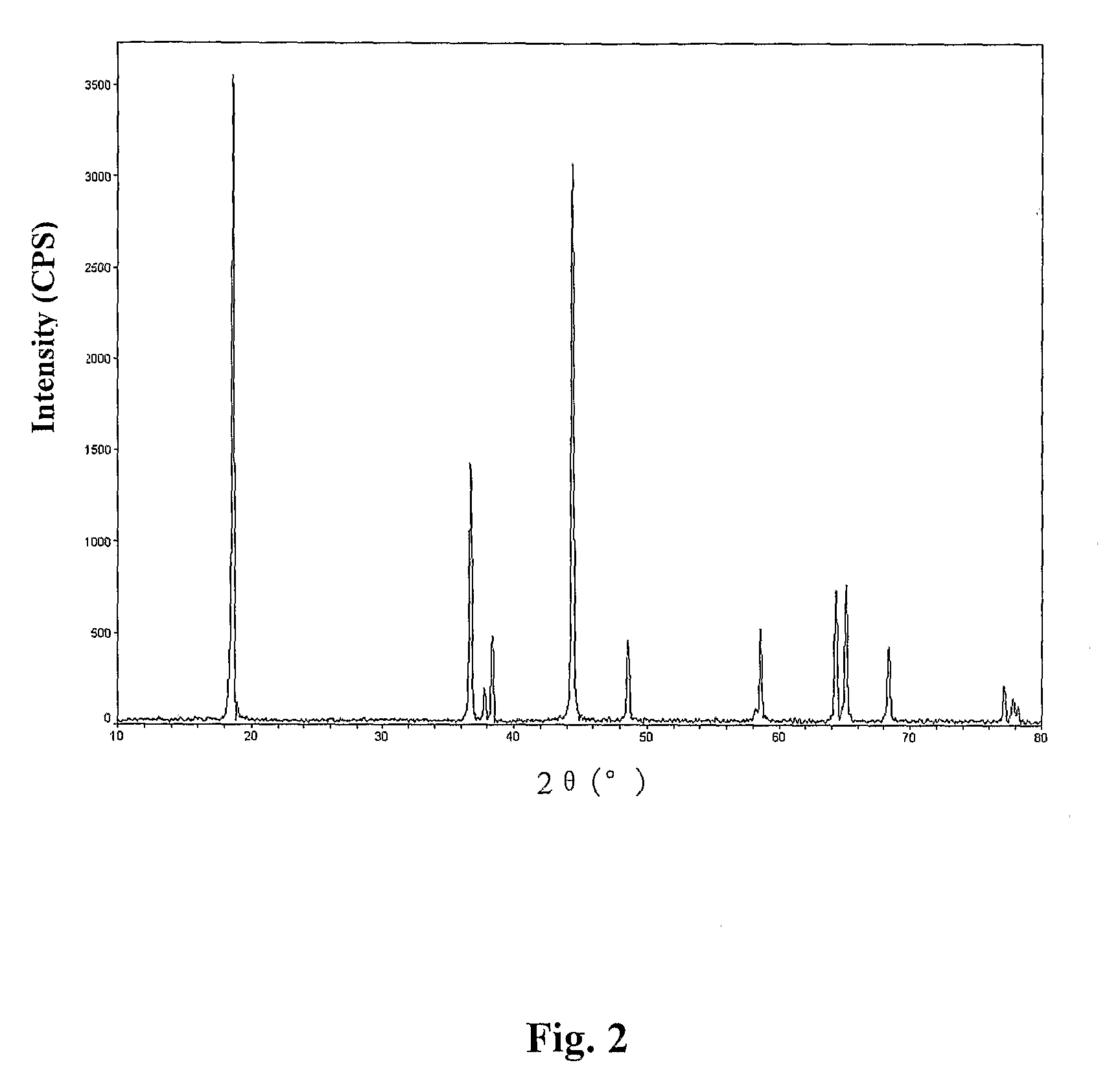Process for preparing a positive electrode material for lithium ion battery
a positive electrode material and lithium ion battery technology, applied in the direction of nickel compounds, non-metal conductors, sustainable manufacturing/processing, etc., can solve the problems of high price, low capacity, high toxicity, etc., and achieve the effect of improving the apparent morphology of the material, high specific capacity, and significant enhancement of the tap density of the positive electrode material
- Summary
- Abstract
- Description
- Claims
- Application Information
AI Technical Summary
Benefits of technology
Problems solved by technology
Method used
Image
Examples
example 1
[0025]The present example is used to describe the process provided by the present invention for preparing LiNi1 / 3Mn1 / 3Co1 / 3O2 used as the positive electrode material.
[0026]1.03 mols LiOH.H2O was dissolved in 200 ml mixed solvent of deionized water and ethanol (1:1 by volume), and 1 mol nickel-manganese-cobalt hydroxide Ni1 / 3Mn1 / 3Co1 / 3(OH)2 was then added thereto. After uniformly mixing by stirring, in a muffle furnace the first-stage sintering was carried out at 600° C. in oxygen atmosphere for 5 hours. The product of first-stage sintering was pulverized in a mortar and then 100 g polyvinyl alcohol aqueous solution containing 5 g polyvinyl alcohol was added. After uniformly mixing by stirring, in the muffle furnace the second-stage sintering was carried out at 850° C. in oxygen atmosphere for 10 hours. After sintering, the material was cooled along with the furnace, and then pulverized by ball milling and passed through a 300 mesh screen to yield the final product LiNi1 / 3Mn1 / 3Co1 / 3O...
example 2
[0028]The present example is used to describe the process provided by the present invention for preparing LiNi2 / 5Mn2 / 5Co1 / 5O2 used as the positive electrode material.
[0029]The procedure of Example 1 was repeated to prepare the positive electrode material, LiNi2 / 5Mn2 / 5Co1 / 5O2, except that Ni2 / 5Mn2 / 5Co1 / 5(OH)2 was used as the nickel-manganese-cobalt hydroxide in place of Ni1 / 3Mn1 / 3Co1 / 3(OH)2 of Example 1.
[0030]The above LiNi2 / 5Mn2 / 5Co1 / 5O2 powder was analyzed with an IRIS Advantange 1000ICP-AES Type Plasma Emission Spectrometer and the determined contents of Li, Mn, Ni, and Co were 7.22% (theoretical value is 7.22%), 22.85% (theoretical value is 22.85%), 24.29% (theoretical value is 22.33%), and 12.25% (theoretical value is 12.25%), respectively. Size analysis was carried out with a MASTERSIZER Laser Size Analyzer and the median particle diameter was determined to be D50=7.63 μm. The XRD pattern of the material was determined with D / MAX2200PC Type X-ray Diffractometer (Science Co., Ja...
example 3
[0031]The present example is used to describe the process provided by the present invention for preparing LiNi1 / 3Mn1 / 3Co1 / 3O2 used as the positive electrode material.
[0032]1 mol nickel nitrate, 1 mole manganese nitrate, and 1 mol cobalt nitrate were dissolved in 750 ml deionized water to prepare 4 mol / L solution, and 1500 ml NaOH aqueous solution of 4 mol / L was slowly added under stirring. The temperature of the solution was controlled at 50° C. After stirring for 8 hours, the precipitate was filtered and dried at 120° C. for 10 hours to yield nickel-manganese-cobalt hydroxide Ni1 / 3Mn1 / 3Co1 / 3(OH)2, 1.05 mols LiNO3 was dissolved in 220 ml deionized water, and after LiNO3 was completely dissolved, 1 mol Ni1 / 3Mn1 / 3Co1 / 3(OH)2 precursor was added. After slowly removing water by evaporation at 65° C. under stirring, in a muffle furnace the first-stage sintering was carried at 650° C. in oxygen atmosphere for 4 hours. The obtained product of the first-stage sintering was pulverized and the...
PUM
| Property | Measurement | Unit |
|---|---|---|
| temperature | aaaaa | aaaaa |
| temperature | aaaaa | aaaaa |
| tap density | aaaaa | aaaaa |
Abstract
Description
Claims
Application Information
 Login to View More
Login to View More - R&D
- Intellectual Property
- Life Sciences
- Materials
- Tech Scout
- Unparalleled Data Quality
- Higher Quality Content
- 60% Fewer Hallucinations
Browse by: Latest US Patents, China's latest patents, Technical Efficacy Thesaurus, Application Domain, Technology Topic, Popular Technical Reports.
© 2025 PatSnap. All rights reserved.Legal|Privacy policy|Modern Slavery Act Transparency Statement|Sitemap|About US| Contact US: help@patsnap.com


